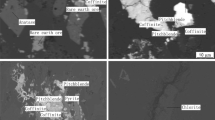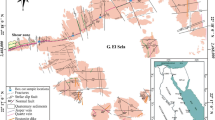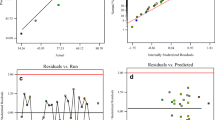Abstract
Many kinetic models for heap leaching of low grade ores have been proposed and the model parameters have been treated as constants. However, some of these model parameters change with the depth of the heap. In the present work an apparatus consisted of six columns with different heights was designed and used to simulate the leaching behavior within a 3-m-high uranium ore heap at a uranium mine in South China. It was found that the model parameters α and ω for heap leaching of the uranium ore varied with the depth of the heap, and that the relationships between α and between ω and the depth of the heap were in the form of the logistic and the quadratic functions, respectively. Furthermore, a kinetic model for heap leaching of the uranium ore considering the variation of the model parameters with the depth of the ore was proposed. The kinetic model gave the fitting precision of more than 95 % and prediction precision of more than 93 %. The present work provided an approach for establishing the kinetic model for heap leaching of low grade uranium ores.





Similar content being viewed by others
References
Mousavi SM, Yaghmaei S, Vossoughi M, Jafari A, Hoseini SA (2005) Comparison of bioleaching ability of two native mesophilic and thermophilic bacteria on copper recovery from chalcopyrite concentrate in an airlift bioreactor. Hydrometallurgy 80(1):139–144
Ghorbani Y, Becker M, Mainza A, Franzidis JP, Petersen J (2011) Large particle effects in chemical/biochemical heap leach processes -a review. Miner Eng 24(1):172–1184
Cariaga E, Concha F, Sepulveda M (2005) Flow through porous media with applications to heap leaching of copper ores. Chem Eng J 111(2–3):151–165
Watling HR (2006) The bioleaching of sulphide minerals with emphasis on copper sulphides-a review. Hydrometallurgy 84(1–2):81–108
Box JC, Prosser AP (1986) A general model for the reaction of several minerals and several reagents in heap and dump leaching. Hydrometallurgy 16:77–92
Dixon DG, Hendrix JL (1993) A mathematical model for heap leaching of one or more solid reactants from porous ore pellets. Metall Trans 24B:1087–1102
Dixon DG, Hendrix JL (1993) General model for leaching of one or more solid reactants from porous ore pellets. Metall Trans 24B:157–168
Mellado ME, Cisternas LA (2008) An analytical-numerical method for solving a heap leaching problem of one or more solid reactants from porous pellets. Comput Chem Eng 32(10):2395–2402
Mellado ME, Cisternas LA, Gálvez ED (2009) An analytical model approach to heap leaching. Hydrometallurgy 95(1–2):33–38
Liu YL, Ding DX, Li GY, Hu N, Wang YD, Wang YT, Wang QL (2010) Comparative study on the precipitates of chemical leaching and bacterial leaching of uranium ore. Chin J Process Eng 04:679–684
Wu AX, Yin SH, Qin WQ, Liu JS, Qiu GZ (2009) The effect of preferential flow on extraction and surface morphology of copper sulphides during heap leaching. Hydrometallurgy 95:76–81
Bennett CR, McBride D, Cross M, Gebhardt JE (2012) A comprehensive model for copper sulphide heap leaching. Part 1. Basic formulation and validation through column test simulation. Hydrometallurgy 127–128:150–161
Lizama HM, Harlamovs JR, McKay DJ, Dai Z (2005) Heap leaching kinetics are proportional to the irrigation rate divided by heap height. Miner Eng 18:623–630
Sidborn M, Casas J, Martinez J, Moreno L (2003) Two-dimensional dynamic model of copper sulphide ore bed. Hydrometallurgy 71(10):67–74
Boyce WE, Diprima RC (1993) In: Lim usa-Noviega Editors (ed) Ecuaciones Diferenciales y Problemas con Valores en la Frontera. McGraw-Hill, México
Mellado ME, Casanova MP, Cisternas LA, Gálvez ED (2011) On scalable analytical models for heap leaching. Comput Chem Eng 35:220–225
Gálvez ED, Moreno L, Mellado ME, Ordóñez JI, Cisternas LA (2012) Heap leaching of caliche minerals: phenomenological and analytical models-some comparisons. Miner Eng 33:46–53
Acknowledgments
The present work was supported by the National Natural Science Foundation of China (Grant No. 10975071).
Author information
Authors and Affiliations
Corresponding author
Rights and permissions
About this article
Cite this article
Ding, Dx., Song, Jb., Ye, Yj. et al. A kinetic model for heap leaching of uranium ore considering variation of model parameters with depth of heap. J Radioanal Nucl Chem 298, 1477–1482 (2013). https://doi.org/10.1007/s10967-013-2522-y
Received:
Published:
Issue Date:
DOI: https://doi.org/10.1007/s10967-013-2522-y




